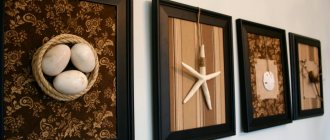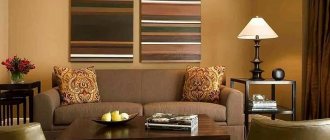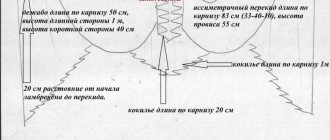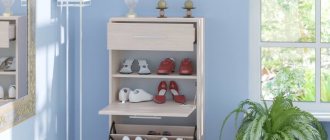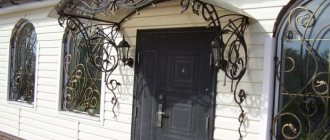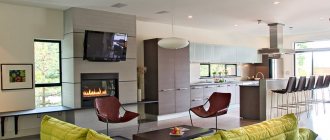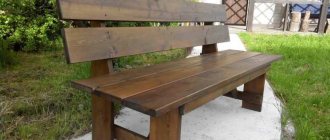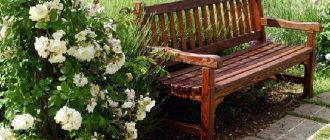SHARE ON SOCIAL NETWORKS
FacebookTwitterOkGoogle+PinterestVk
Gypsum stucco is always in fashion, and its use in decoration will make the interior unique and inimitable. Even in small quantities, if it is skillfully made and correctly applied, such decor will become an exquisite addition and will favorably emphasize the dignity of the room. In addition, stucco molding will help visually adjust the space and hide various irregularities on the surface of the ceiling and walls.
Gypsum stucco molding is always relevant and suits different styles
In what interior style is plaster stucco molding acceptable?!
For the harmonious use of modeling in interior design, you need to carefully consider the style and concept of the room. Exquisite moldings, figurines and picture frames will not suit every room design. Country, Provence or Scandinavian styles generally do not allow such elements in their interior. They will be very provocative in designs such as loft, minimalism and hi-tech.
The modeling in the listed projects will look pretentious and completely tasteless, like leftover elements of past decor. But there are a lot of other design solutions where gypsum elements will come in handy.
Where to buy plaster for crafts
The easiest way to buy plaster is at a hardware store. In order not to get confused in the variety of its types, you need to be able to read the labeling.
The numbers after the letter “G” indicate compressive and fracture strength and purpose:
- G2...7 – building gypsum (alabaster).
- G13…16 – high-strength molding
- G22…25 – super durable medical
G6...16 is best suited for crafts. Next are the letters indicating the setting time:
- A – quick-hardening, 2 – 15 min.
- B – normal hardening, 6 – 30 min.
- B - slow-hardening, 20 minutes - several hours or days.
Next is the grinding fineness in Arabic or Roman numerals:
- 1 – rough
- 2 – average
- 3 – thin
For example, G-7 A1: gypsum, withstands 70 kgf/cm2, sets quickly, has large particles.
Art Deco
Art Deco is the option when a combination of something completely incompatible at first glance is acceptable. Creative execution can include all possible chic items.
It is not necessary to adhere to any single type of plaster elements; you can combine classic designs on vases and niches with modern figurines.
Typically, this style is preferred by people with an active lifestyle who value comfort and luxury in one set.
Flaws
However, with all its advantages, gypsum has a number of disadvantages:
- You need to work very quickly with the prepared solution. Depending on the type of plaster, it hardens in 7 to 30 minutes.
- Repeated stirring, the so-called “remelting”, is impossible.
- Special conditions are required to work with plaster because the process is wet and dusty.
- It is inconvenient to work with gloves, and without them the skin dries out very much.
- Gypsum crafts absorb water well, so they must be varnished. And even a protective coating does not always save you outdoors.
- The products, although rigid, break easily and do not withstand mechanical stress well.
Empire style
Empire style is a style in which decorative stucco molding acquires solidity and key importance. The status of a room in the Empire style is sometimes breathtaking, and the owner of such a room feels like a true pharaoh of our time.
The gypsum elements here are massive and monumental. Small stucco elements can only add to the mood.
Decorative finishing using stucco
The main advantage of decorative stucco on the walls is its combination with various trends and styles, ranging from timeless classics to modern minimalism.
Thanks to a special molding technique and an asymmetrical order of elements, stucco can hide many surface defects, cover communications, and also add elegance to the most ordinary niche in the wall.
Today, such decorations include stucco borders, pedestals and pilasters, brackets, as well as domes, bar counters and bookshelves. At the same time, instead of a border for the ceiling, gourmets prefer to use decorative cornices, which add solemnity and sophistication to the interior.
Materials for making stucco molding
Stucco can consist of wood, artificial polymers and gypsum. As for the first type, this is an environmentally friendly and quite expensive building material. The latter is also good, but it is difficult to install. Thus, modern types of plastic remain - polystyrene and polyurethane.
So which is better? Polyurethane is much cheaper than polystyrene and lasts up to 30 years, while the latter quickly loses its appearance. If you care about your own health, then the polyurethane stucco option will meet all the requirements and be hypoallergenic. Moreover, such products are known for their clear drawing; they can be laminated and primed with water-based emulsion.
Gypsum is a material that, when hardened, expands and, under pressure, penetrates into the smallest relief depressions, which adds special advantages to it. Thanks to this property, designers can realize the most sophisticated fantasies and transform the existing interior into an exclusive place to relax.
Rococo
Rococo style implies light and flirty elements. Lush, but at the same time weightless forms give the room romanticism and a feeling of heavenly stay.
Asymmetry and elaborate crimp perfectly complement the image of such a design. Great importance is attached to painting elements in gold or patina.
How to dilute plaster for crafts
Depending on the task, the solution can be of different thicknesses:
- Liquid – 1 kg of gypsum per 0.7 liters of water.
- Normal - 1.5 kg per 1 liter of water.
- Thick – 2 kg per 1 liter of water.
To prepare the solution, you need to take a suitable container. Fill with water first - this will reduce dust. Then slowly add the powder, stirring constantly. It is convenient to mix large quantities with a drill and whisk. There should be no lumps in the solution.
Renaissance and Romanticism
Renaissance and Romanticism are somewhat similar to each other, as they allow multi-level ceilings and walls with numerous niches. If the Renaissance also needs figurines, then romanticism is distinguished by the lightness and individuality of its owner.
Types of stucco decoration
Moldings
One of the most popular types of stucco in modern interiors, although it is used in any style. Moldings are volumetric strips that are used on any surface, modeling space. With their help, you can add volume to a simple finish, highlight certain areas or highlight the decor.
Instagram @natamodo
Instagram @enjoy_home
Instagram @zhilin_brothers
Instagram @quadro_room
Instagram @malitskie
Cornices
Ceiling cornices with stucco molding are used as an analogue of floor plinths, covering the joints of walls and ceiling with them. They can be either patterned or completely smooth. Such planks play a decorative role; their color can match both the ceiling and the walls - depending on this, the height of the room will appear larger or smaller.
Instagram @lesya.pechenkina
Instagram @ruger_design
Instagram @zhilin_brothers
Instagram @studiolawahl
Instagram @natamodo
Friezes
A frieze in the modern sense is a wide border with a pattern that runs along the perimeter of a ceiling, window or doorway. Sometimes it is imitated, but the real frieze is convex, but its surface can be either embossed or smooth.
In the interior it acts primarily as a decorative element, often used in classics or neoclassics. It also visually lowers a ceiling that is too high, making the proportions of the room more harmonious. The larger the frieze, the lower the room appears, so you need to be careful with this element so as not to overdo it.
6 photos
Instagram @we.ar.1
Instagram @nikitinadesign
Instagram @polinov
Instagram @we.ar.1
Instagram @nikitinadesign
Instagram @ancconcept
Columns and semi-columns
Stucco molding in the form of columns is rare in city apartments. The elements consist of three parts: the lower support, the pillar itself and the top (this can be a pilaster or a capital, usually of a decorative nature).
Instagram @natamodoInstagram @mikhailova_interior
Sockets
They are a patterned composition that decorates the mounting of the lamp to the ceiling. Most often, the rosette pattern is located in a circle, but there can also be free forms. The ornament is painted to match the canvas or made contrasting.
Instagram @a_gorskaya
Instagram @taupehome
Instagram @nikitinadesign
Instagram @a_gorskaya
- Decoration
7 mistakes in using stucco that make the interior tasteless
DIY plaster modeling
The variety of choices in shops and decor shops will not leave you indifferent, but sometimes you really want to create something with your own hands, because the result will become a true source of pride for its owner. Decorative plaster modeling is a creative and very exciting activity, but it is labor-intensive and requires certain skills.
Preparation of the solution:
- Grind the gypsum well to a powder and sift through a sieve;
- pour into a container with sufficiently high edges;
- Gradually add water in small portions until it reaches the consistency of kefir;
- stir with a special attachment using a drill, this will avoid the formation of unwanted lumps.
Modeling on the wall: tools and main stages of work
To work with plaster modeling you need a certain set of tools. With mastery comes the need to use a set of various modeling spatulas (palette knives), knives, brushes and pastry syringes with attachments. At the initial stage, it is quite possible to get by with a pair of knives, a spoon and an indispensable attribute - half a rubber ball (for kneading the working mixture).
The wall must be leveled to within 2 mm/m, primed and cleaned. This is followed by coating with the base composition and background plaster with tinting of the base. The relief is applied by direct modeling or using prefabricated elements. If necessary, the dried relief is tinted and painted with special paints. After drying, the paints take on a faded appearance, but a final coating with styrene-butadiene latex restores their brightness.
To create stucco molding you will need special spatulas called palette knives.
After preparing the wall, you need to make a sketch of the future composition. This will make the work easier in general and will allow you to identify problem areas on the work surface. Repeating details can be applied using stencils prepared in advance from thick paper or cardboard. And also stucco elements from gypsum are made using the casting technology discussed above.
The formation of the stucco bas-relief is carried out layer by layer. The working mixture for plaster modeling is applied with a brush and a pastry syringe, and then leveled and shaped with palette knives. When creating a colored bas-relief, the batch of each layer is tinted using gypsum pigment, with the concentration decreasing as the relief grows. The texture is added to the still wet mixture with a brush and finished over the dry mixture with sandpaper.
Mold making
To make gypsum stucco molding look beautiful with your own hands, you need to choose or make the right matrix for casting yourself. You should not save either money or time on this. Cheap templates stretch, have inaccuracies, and may break. Metal patterns are of high quality and durability. They cost several times more, and they are usually made to order.
Silicone is suitable for creating a template at home. When handling it, you need to take into account the following features:
- less durable than metal ones;
- the composition does not spread well over the workpiece.
These problems can be solved. For greater strength, a frame is made of alabaster or other hard material (plastic, wood) under the silicone template. To make the gypsum solution easier to distribute over the impression, the latter is lubricated with a liquid that improves sliding.
The finished model is coated with silicone using a brush. At this stage, it is important to prevent bubbles, which will lead to unevenness in the plaster decor. After applying the first layer, reinforcement is done - gauze is laid, then repeated 2-3 more times. The thickness of the silicone should be 3-5 mm. The gauze should not be stretched so that when compressed it does not deform the product. Each layer of silicone takes 2-3 hours to dry.
After final drying, the silicone blank is removed from the model. For greater stability, a frame or base is constructed. The first one is made from boards according to the dimensions of the workpiece. The second is cast from alabaster. It follows the contours of the silicone template and does not allow it to change when pouring plaster.
Removing the silicone mold from the model
Advice! For small molded units, ready-made silicone blanks are suitable, intended for creating soap, candles, and confectionery. They are presented in a wide range in the creativity departments.
Children's creativity
Young children enjoy working with plaster. There are many molds for sand, snow, and baked goods in which you can cast plaster crafts for kindergarten.
The technology is simple enough even for a child:
- The mold is first lubricated with a mixture of liquid soap, vegetable oil and water in a ratio of 2:1:5 to make it easier to remove the finished product.
- Pour in the solution. You can mix it with the addition of any color.
- Use a ruler or spatula to run along the edges of the mold, cutting off excess.
- If you plan to hang the toy, then stick a cocktail straw into the right place.
- If the figurine has two front sides, another identical one is cast, so that later they can be glued together with the back sides.
PVA glue, liquid nails, “Titan”, “Moment” are suitable. The joint area is sanded. If necessary, lubricate. Coloring is limited only by the child's imagination.
Domes
Used as ceiling decoration in the Empire style. You can create a painting on the dome by hanging a chandelier inside, which will be a rather original solution.
Remember, well-chosen decor will transform any room. And if you decorate an ordinary wall surface with stucco, you can get cozy, extravagant apartments, where many emotions reign - from severity to solemn pomp.
The material was created with the support of: https://designstilno.ru
Creation technology
First, prepare the silicone pattern - clean it from dust and small particles. To make it easier to remove the plaster figure, a release silicone grease is applied to the template. To do this, use a brush to treat the entire surface, leaving no uncovered areas. In untreated areas, the composition will set tightly; removing the hardened product without damage will be problematic.
The prepared solution is poured into lubricated matrices. It is recommended to do this in two steps:
- Apply the first layer of gypsum mixture with a brush. In this case, you need to make sure that there are no air bubbles left. When they burst, depressions and cavities will form on the figure, and the surface will not be uniform and smooth.
- Fill the container to the brim.
Advice! Large-sized works or works with thin parts are recommended to be reinforced with reinforcement. To do this, after applying the first layer of gypsum, a painting mesh is placed in the mold. Then fill the remaining space.
Afterwards, the structure must be gently shaken to release air bubbles. The back part needs to be leveled with a spatula. If it turns out to be lumpy, then fixing it to the wall or ceiling will be unreliable. There will also be noticeable gaps between the figure and the wall. Additional effort will be required to seal the cracks and level them.
The gypsum solution is kept for 20 minutes, after which it is carefully removed. If you do this earlier, the alabaster that has not completely set will be damaged. If left for a longer period of time, the plaster will harden greatly and adhere to the silicone template. Deformations may occur during removal.
The finished part is left to dry for a day. The air temperature should not be lower than +16℃.
Drying finished parts
